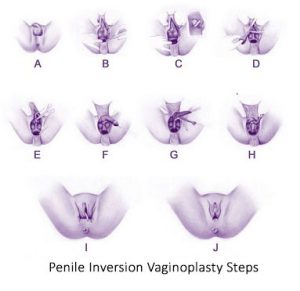The answer to that is no. The simple reason for this is that our own SIGMA-LEAD GCS/SRS technique uses a rectosigmoid colon graft to create the neovagina. No penile or scrotal skin is used for that purpose since they don‘t meet the demands of a vagina and are way too hard to maintain post-op. However, some of the steps we use throughout our 2-stage one-time surgery are similar than with penile inversion approaches.
The vaginal cavity is created by carefully dissecting the area between rectum and bladder. Dissection is continued all the way to the peritoneum. In the penile inversion technique, the peritoneum is left intact.

In a regular penile inversion approach, the penile skin gets pulled down as much as possible to line the vaginal cavity with the largest available amount of penile tissue possible. It‘s understood that this tension is counterproductive in so many ways, as well as using valued penile skin for the vaginal lining.

This is where Dr. Kaushik‘s approach goes different ways. In a refined procedure, he uses pedicled tissue (with nerve and blood supply) to create the clitoral hood and the labia minora as well as the inner side of the labia majora.
He also performs a well-refined clitoroplasty that changes the glans into a clitoris of natural size and shape. He then positions the urethra at the proper location, just like in a biological female. Remaining penile skin will be attached absolutely tension free at the vaginal entrance. This is what Dr. Kaushik calls stage 1 of the SIGMA-LEAD GCS/SRS technique.

The patient has the choice of leaving it as it this being cosmetic GCS/SRS or stage 2 of the SIGMA-LEAD GCS/SRS will follow immediately, or at any later date, should the patient choose to do so. Yes, you can opt for the second stage also at a later time.
As you can see, this procedure has only very few elements of a penile inversion surgery in common. That is also the reason why it has a different name.
The steps involved in the OLMEC cosmetic GCS/SRS are far too advanced and different from regular penile inversion approaches.
